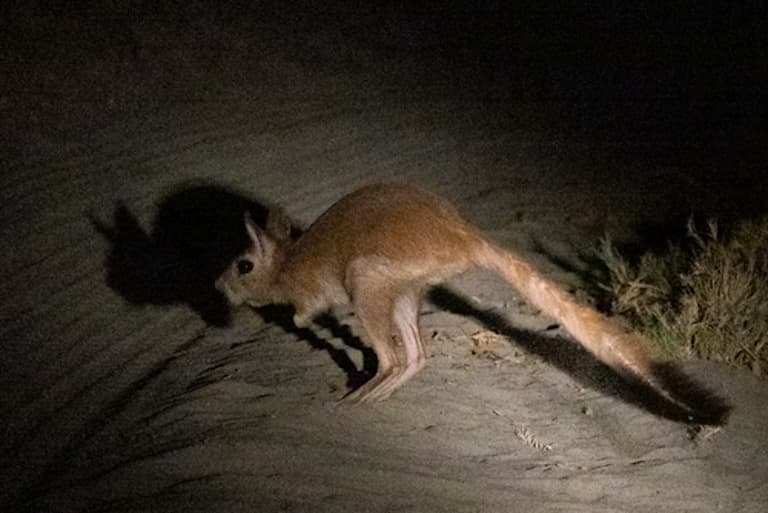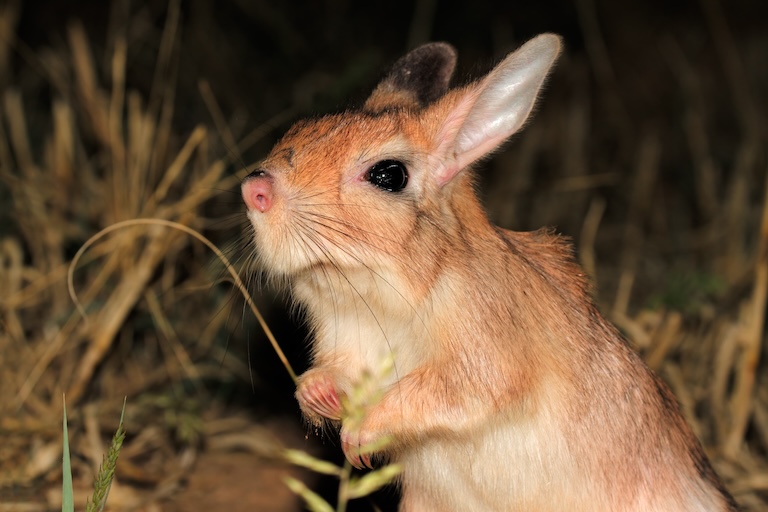Springhare Profile
Taxonomy has come a long way since the discovery of molecular markers and DNA sequencing. Before that, taxonomists tried their best by looking really closely at animals to group them together as closely as possible. This works for a lot of animals; rabbits and hares are quite obviously similar and, as it turns out, closely related.
For others, it’s harder. Termites and ants are remarkably similar but not remotely related to one another. And other animals appear to have bits and pieces of everything, making them impossible to place by looks alone.
The Springhare is an example of this: an animal with the face of a rabbit, the legs of a kangaroo and the expression of McKayla Maroney.

Springhare Facts Overview
| Habitat: | Grassland, savanna |
| Location: | Southern and Eastern Africa |
| Lifespan: | 13+ years |
| Size: | 30cm (12 inches) at the shoulder, tail up to 48cm (19 inches) |
| Weight: | Up to 4kg (8.8 lb) |
| Colour: | Golden brown |
| Diet: | Grains, grasses, stems, roots, some insects |
| Predators: | Jackal, Lion, snakes, mongoose, owls and eagles |
| Top Speed: | Unknown |
| No. of Species: | 2 |
| Conservation Status: | Least Concern (IUCN) |
Springhares aren’t from a place with Spring and they’re not hares at all. They’re sometimes called “mini-kangaroos” but they’re not marsupials, either. They’re an unusual remnant from a mostly extinct line of rodents that appear to have features stolen from a variety of other mammals.
They’re solitary in the wild (though in captivity they seem to enjoy one another’s company), and they’re fantastic at both leaping and burrowing. The latter of which has unfortunately put them into conflict with the ever-expanding human element.
Interesting Springhare Facts
1. They’re not hares
Springhares, or Springhaas in Afrikaans, are not named after the season. For one thing, there is no recognisable Spring in most of their range – especially in East Africa. Spring is a Germanic word for Jump, and this is where they get the first half of their name.
But they’re not hares, either, although they do look a bit like them. Instead, springhares are rodents. Once grouped with the similarly gangly Jerboas, and then placed with porcupines, for some reason.
Now, it’s thought that they’re not a member of any of these families, and instead occupy their own, distinct group called the Pedetidae. This family once contained at least six genera and more than 14 species, but now contains only two species in one genus: Pedetes capensis from the Cape, and Pedetes surdaster, from Eastern Africa.
So, they’re not hares, but when you look at them you can see how they got their names. 1
2. They have a strange mix of features
Springhares look a bit like a mix between a rabbit, a hare, a kangaroo, and (apparently) a porcupine.
These are peculiar animals; large, with long legs and a fluffy counterbalance of a tail with a dark tip. Their huge round eyes sit on a face with the perpetually unimpressed expression of a silver medallist, and a head shaped a lot like Spike, the charismatic dancing rabbit from Moonwalker.
The ears are huge, and they have a foldable flap over them called a tragus that helps them keep sand out. They have sharp claws on their front legs and unlike most rodents who have five toes on the back legs and four on the front, these guys have the opposite. The hind claws are so thick they’re almost hoof-like, adding to the assemblage of unusual features.
But it’s the Spring part of the name that is particularly apt. 2
3. They’re kangaroo-like
The back legs of this animal are evolved for leaping. They’re sometimes called “mini-kangaroos” by unimaginative people for this reason, and combined with their tail, these features give the Springhare its incredible jump.
When moving they hop in bounds of around 20cm, but when leaping, they can surpass three meters in distance. 3
When moving they hop in bounds of around 20cm, but when leaping, they can surpass three meters in distance. 4

4. But they burrow
But all of this is terrestrial behaviour. And Springhares can do a lot more than bound across the surface. They’re also excellent burrowers and their abodes are riddled with passages, leading to multiple entrances.
When exiting through one of these portals to the outside, they will take a massive leap, possibly to hide the point of entry from anyone watching, or to blast past the waiting gaze of a would-be predator lying in wait.
They’ll spend most of the day underground, having plugged one of the entrances with dirt. They’ll occupy different burrows on different days, probably for hygiene reasons, but these burrows will usually be located in the vicinity of their favourite large tree.
At night, they’ll venture out, only up to around 250m from the safety of their burrows and will retreat very quickly if disturbed.
And they’re mostly solitary, or part of a nuclear family group, so in many cases, a Springhare has the burrow more or less to itself. 5
5. They’re biofluorescent
For some reason yet to be established, Springhare fur is biofluorescent.
Fluorescence is different from luminescence, in that it requires a light source. Bioluminescent organisms produce their own light, but in biofluorescence, it is the absorption and reemission of light that creates the phenomenon.
Fluorescent organisms have proteins built into their skin or other tissues that absorb energy from sunlight and reemit it as a different colour. It’s commonly seen in animals such as salamanders, invertebrates, and other alien-like creatures, and is a lot less common in mammals.
Areas of the springhare’s body that relate to grooming and social interactions appear to be the most bio-fluorescent, suggesting some intra-specific adaptation, and perhaps relates to the low-light environment the Springhare occupies. 6
6. They can regenerate, a bit
Regeneration is the holy grail of modern medicine. Cracking the code for how some animals regrow stuff might grant us a revolution in healthcare. As humans, we have barely any regeneration. When our tissues are injured, they’re replaced with scarring, rather than fresh tissue, and this is essentially shoddy work.
Some animals, like spiders and even some amphibians and reptiles, can regrow entire limbs, and the genetic difference between us is apparently a lot less than we once thought. Instead of losing the genes for regeneration, it’s thought that humans just have it turned off, which might mean it’s a much easier problem to solve than it would be if we needed to inject salamander genes into humans.
Springhares, much closer in evolution to humans than reptiles or amphibians, can regenerate parts of their ear. This is actually not such a surprise, as rabbits can do it, too. Still, it’s a teasing reminder of how close we might be to regenerating damaged tissues in the future.
7. They’re running out of space
Unfortunately, it doesn’t matter how much regeneration an animal is capable of if there’s nowhere to live. And the Springhare is running out of viable habitat each day. The major challenges are human settlements and ranching, which take up so much space in the world, wild animals everywhere are struggling to find their safe space.
Further, these things come in direct conflict with the burrowing Springhare, which is often treated as a pest and killed.
This is an animal who loves grain, which also puts it at odds with grain farmers, who quite like it too. At the moment, both species are of Least Concern to the IUCN Red List, but they have an uncertain future.

Springhare Fact-File Summary
Scientific Classification
| Kingdom: | Animalia |
| Phylum: | Chordata |
| Class: | Mammalia |
| Order: | Rodentia |
| Family: | Pedetidae |
| Genus: | Pedetes |
Fact Sources & References
- “Springhare”, African Wildlife Foundation.
- “Pedetidaespringhare”, Animal Diversity Web.
- “Springhare”, Ingwelala.
- “Springhare”, Ingwelala.
- “Pedetes capensis South African spring hare”, Animal Diversity Web.
- Erik R. Olson (2021), “Vivid biofluorescence discovered in the nocturnal Springhare (Pedetidae)”, scientific reports.
